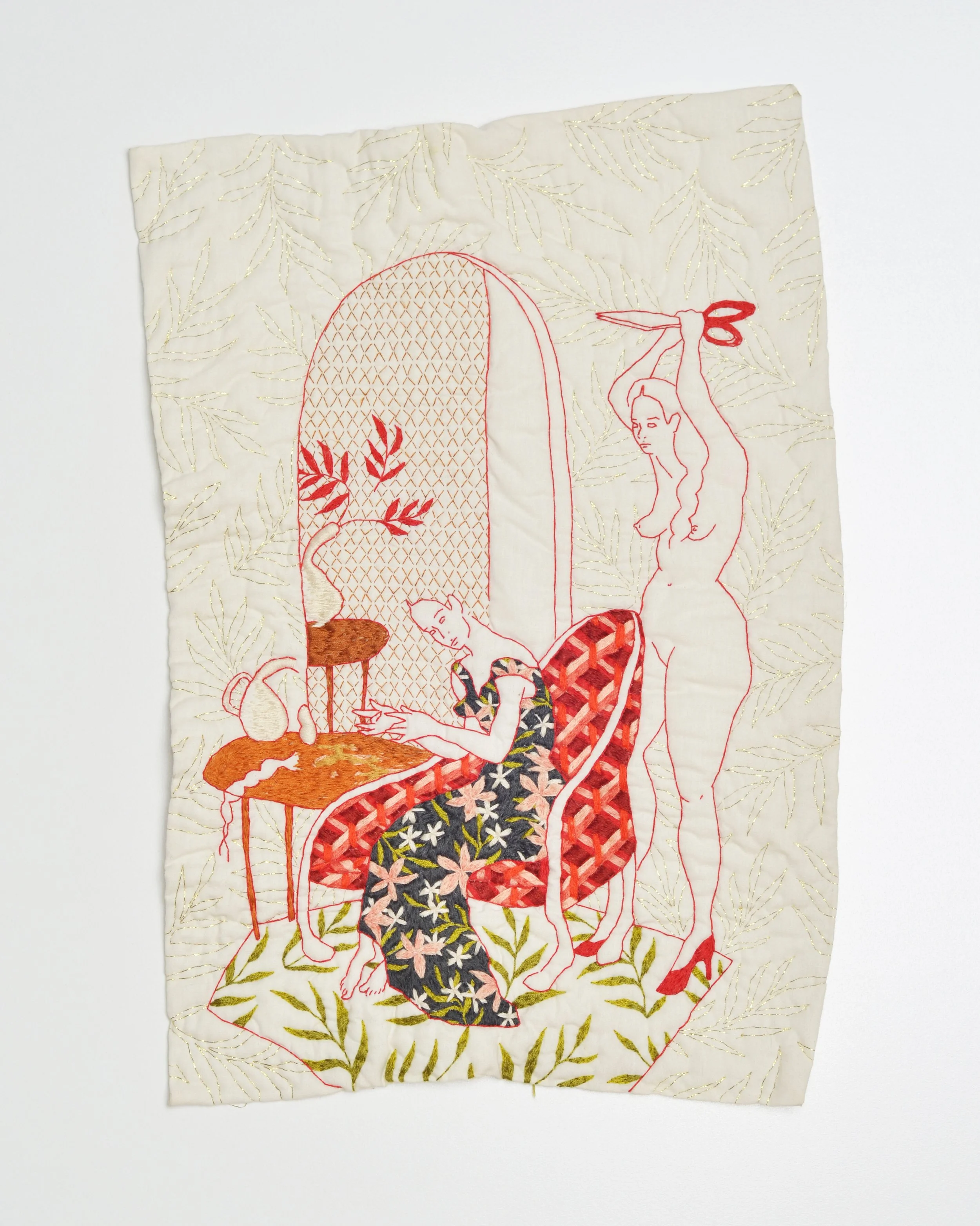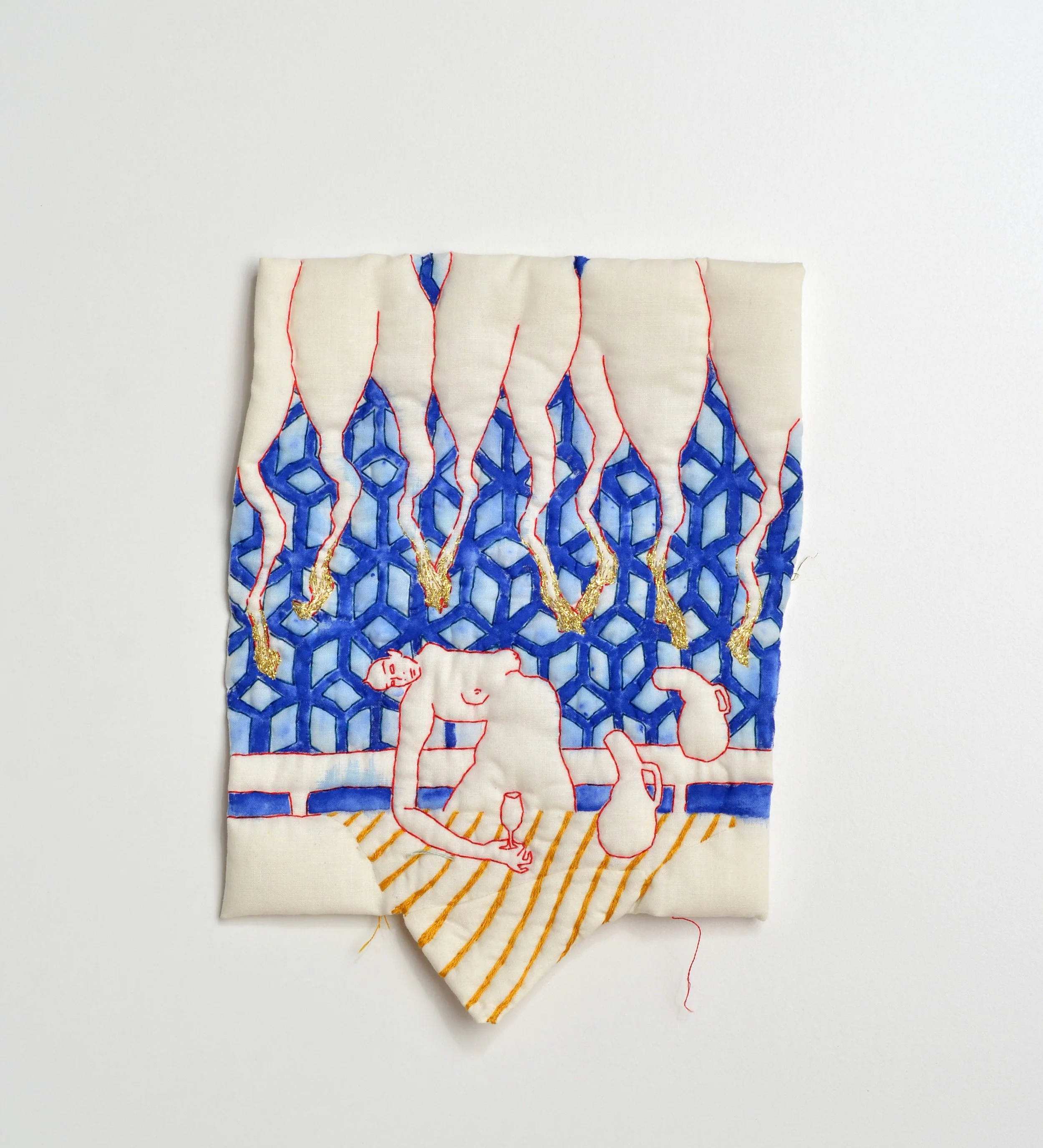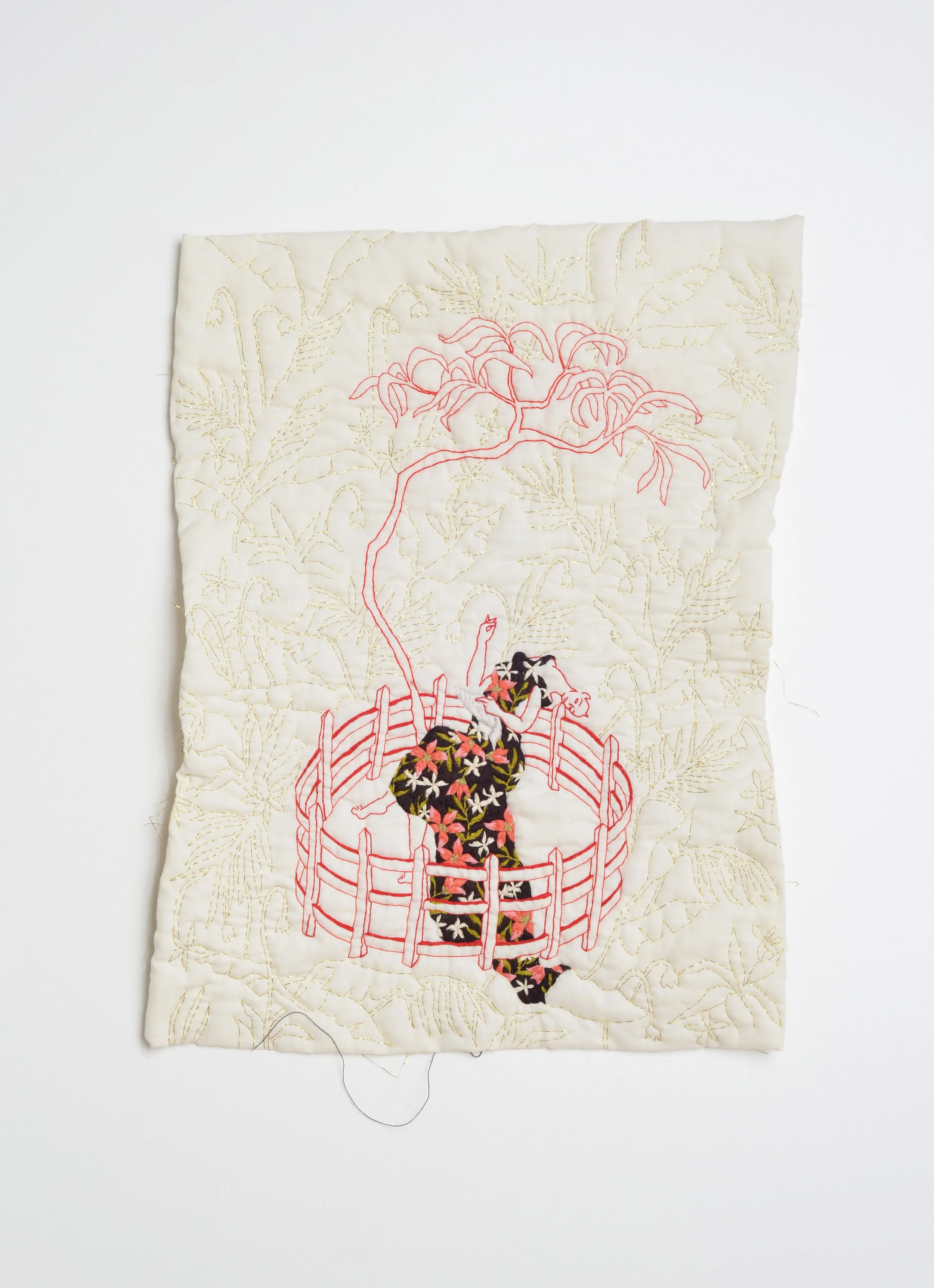Backstabber, 2022. Hand embroidery. 34 x 46 centimeters.
Nicole Mazza
BIO
Nico Mazza was born in Gainesville, Florida in 1989. She received her BFA from the School of the Art Institute of Chicago in 2011 and lived and worked in New York City until 2014 when she moved to Buenos Aires, Argentina. She has participated in many group exhibitions in the US, South America and Europe and recently presented her latest body of work in a solo show titled "Blandir el Quiebre" (Softening the Break) at Crudo Contemporáneo in Rosario, Argentina. She has also shown work in various art fairs including ArteBA (Buenos Aires), Frieze (London), and Pinta (Miami). Her work was selected for numerous art competitions including "El Fugaz" (2019 and 2022), "Fondo Nacional de las Artes (2021) and "Salon Nacional de Artes Textiles" (2022). She is currently represented by Crudo Arte Contemporáneo in Rosario, Argentina.
ARTIST STATEMENT
Nico works with textile and embroidery to create figurative works. She integrates strong pictorial and sculptural resources in a baroque, poetic narrative that raises questions about the construction and deconstruction of the body. She is concerned with the iconography of the body and how it is seen through the lens of socially constructed relationships and fantasies, and how gender is constructed, deconstructed, and reconstructed- devoured, fragmented and rebuilt by the voyeur.
Nico stitches together dream-like landscapes and interiors filled with pattern and texture. Images are formed from memories, family histories and fantasies, often juxtaposing the delicate practice of needlework with characters who negate socio-political norms of gender and sexual identity.
Her figures are often contorted: bodies in positions of discomfort and impossibility. Limbs are intertwined, wrapping, reaching and wanting. Though they are sometimes nude and sexualized, observed and objectified, they take front and center stage - autonomous and engaging in the extremes of human behavior.
Interview with Nicole Mazza
Encuentro Entre el Acá y el Más Allá (Meeting Between the Here and There), 2022. Hand embroidery. 56 x 45 centimeters.
Can you tell us a bit about your background and how you became interested in becoming an artist?
I was born in Gainesville, Florida, a university town in the middle of the state, and proudly an island of blue in a politicly red area of the country. I lived mostly with my mom and spent almost all of my free time at my grandparents house. My grandmother was a seamstress and she had her studio set up in the garage. I was constantly “helping her” sew, or cutting pieces of fabrics and string. She had many boxes full of buttons and notions and I remember the joy I had the days that she would let me take them down from the highest shelves and explore with wonder. This was the beginning of an exploration of my creative process, though I didn’t know it yet. When I was eleven, my father passed away in an accident and art became an escape for me. I passed the time painting and drawing and expressing myself in ways that I couldn’t with words. I ended up studying painting at the School of the Art Institute of Chicago and didn’t even touch fabric until my last year of college when I took a fibers class. I started embroidering one of my paintings and connected again with textile. Over time i started painting less and sewing more, and slowly the pain started fading out altogether, and the rigid four sides of a canvas also started melting away.
Can you tell us about some of your most memorable early influences?
My grandmother Judite is my earliest influence. She had a really interesting life that centered around the tradition of sewing. She was a very religious person, catholic. When she was young she had a boyfriend that died in her arms and she joined a convent to become a nun. During this time she worked teaching sex workers to sew. At some point she left the convent, met my grandfather and decided to start a family. My grandfather tried many times to get a visa to work in the US but it was my grandmother who was able to find work making mens coats in a factory in New Jersey. As i mentioned before, she passed down her knowledge of these traditions to me. Sewing, embroidery, lace making, and all things that have to do with textile. She taught me to touch, to put things between my fingers and feel their essence. She taught me the importance of material, of quality.
Where are you currently based and what brought you there? Are there any aspects of this specific location or community that have inspired your work?
I am based in Argentina. At 18 I started dancing Tango, drawn to the music and the nostalgia i felt when I first heard it. Tango accompanied me when I changed cities, when I moved to Chicago for School, to New York for work. It’s amazing because anywhere I go in the world, I have community. In 2014 I decided to take a trip to Buenos Aires, where tango originated and what is the mecca of tango today. I instantly fell in love with the city and was able to live my other passion daily (well nightly.) I loved it so much I decided to stay. This changed my practice in a very material way because I was living out of a suitcase and unable to set up a studio. Embroidery was something I could take with me anywhere. It was the nail in the coffin for my painting practice. Chau oils and paint thinner.
Rica, Tierna (Sweet, Soft), 2022. Hand embroidery. 20 x 27 centimeters.
What is your studio space like? What makes your space unique to you?
I have a studio in an office space with other artists from my gallery. I share my space with a friend and peer and love the social quality of showing up to a space where other people are making and creating work all of the time.
My studio is generally pretty messy. There are bits of fabric and string everywhere, piles of embroidery thread and sketches of future embroideries. I do have a very large white table in the middle that is my sacred space, a sea of calm and order.
What is a typical day like? If you don't have a typical day, what is an ideal day?
Wake up early. Make a cup of delicious coffee. Coffee is important. Walk two blocks to my studio where I then drink said cup of coffee while I look over sketches or do work on my computer. Then sew, sew, sew. I usually work until about lunch time then work from home in the afternoon while my partner takes a nap. Siesta is a real thing here. In the evenings I usually dance, my partner and I are professional dancers so we try to practice every day. Some nights we go to the milonga (social club for tango dancing).
What gets you in a creative groove or flow? Is there anything that interrupts your creative energy?
Cafe con leche in the morning. Mate in the afternoons (mate is a special tea from Argentina and Uruguay. The cellphone is a huge distraction. I try to stay away from scrolling while in the studio. Tango is also a distraction, although one I choose and have now come to see as another form of expression. The milonga is the real distraction. It keeps you out until 5 in the morning, and the next day I am just useless in the studio.
What medium/media are you working in right now? What draws you to this particular material or method?
I primarily work with textiles and embroidery. I am drawn to it because of the tactile nature of fabric. I like that it is something visually delicate but actually quite strong and durable.
I have also recently started dabbling in ceramics. Because embroidery is so methodical and planned, I liked the idea of a material that I could react to. Making something that I didn’t know how was going to end up from the beginning. I have also realized that ceramics is also quite methodical. :/
Can you walk us through your overall process in making your current work? Does drawing play a role in your process?
I usually start by doing research, planning the story I want to tell and building images through sketches on my iPad which allows me to try different options quickly. I then draw the finished sketch onto the fabric, and prepare my surface - which is many layers of fabric and batting. Then sew sew sew.
Self Portrait as a Unicorn, 2022. Hand embroidery. 34 x 46 centimeters.
What is exciting about your process currently?
As i mentioned before, I have started working with ceramics. Its something totally new for me and I like the idea of bringing things from the embroideries to life in 3 dimensions. I have also started thinking about embroidering clay, unfired and fired.
Can you talk about some of the ongoing interests, imagery, and concepts that have informed your process and body of work over time? How do you anticipate your work progressing in the future?
My works are heavily influenced my renaissance imagery. I like reimagining images that are a part of our collective visual language. I think the is something that stuck with me from when I was a child surrounded by images of idols at my grandmothers house. I think I will continue to work with embroidery but anticipate focusing more on installation and how the embroideries live in a three dimensional space.
Do you pursue any collaborations, projects, or careers in addition to your studio practice? If so, can you tell us more about those projects, and are there connections between your studio practice and these endeavors?
Tango is my other passion and is something I am persueing professionally. My partner and I compete, exhibit and teach tango. I also direct a project called “A Nuestros Pies,” where in collaboration with other dancers we fuse the visual arts and tango.
Siestera, 2022. Hand embroidery. 20 x 29 centimeters.
Have you had any epiphanies recently that have changed the course of your work or caused you to shift directions?
I mentioned before that i have started embroidering clay. I love the idea of mixing hard and soft - embroidering something that is impossible to penetrate. I think there is more here to investigate. Clay is just the beginning.
Can you share some of your recent influences? Are there specific works—from visual art, literature, film, or music—that are important to you?
The Last Mourning, The Last Supper, Goyas Disaster Series, Berni,
Pugliese. Pugliese. Pugliese.
Spanish Telenovelas, The Color of Pomegranates, Cinema Paradiso
Crime podcasts
I always have something Im watching or listening to while sewing. I love fantasy an sci fi genres. My greatest discovery was the free audiobook app from my library.
Who are some contemporary artists you’re excited about? What are the best exhibitions you’ve seen in recent memory and why do they stand out?
Felipe Baeza, La Ruman, La Chola. Sophia Narrett (also works with embroidery), Melissa Joseph, Ricardo Partida I was blown away by Chiaccho y Giannone’s, exhibition. They are a couple who create large scale hand embroideries. To see the scale of the works in person was so impressive. I love seeing other artists who work with textile and embroidery.
Cambio de Viento (Change of Heart), 2022. Hand embroidery. 32 x 45 centimeters.
Do you have any tips or advice that someone has shared with you that you have found particularly helpful?
Make when you feel like making. If your inspired, ride the wave. You can always sleep later, or when your dead.
What are you working on in the studio right now? What’s coming up next for you?
Currently I am working on a new body of work titled ‘El Deseo de No Querer’ (the desire of not wanting) for a solo show in Buenos Aires at the end of April. Apart from the embroideries, I will also be showing some ceramic vessels and playing a bit more with installation. Im really interested in bringing the embroideries to life, pulling elements from the two dimensional images I create and putting them into a three dimensional space.
To find out more about Nicole Mazza check out her Instagram and website.






